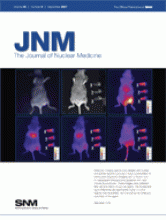Reduced role for V/Q scintigraphy: Strashun reviews the evolution of multicenter trials of ventilation/perfusion scanning in acute pulmonary embolism and assesses the comparative merits and diagnostic refinements of multidetector CT imaging.
Page 1405
Quantum dots for molecular imaging: Lee looks at current investigations of this promising nanoparticle technology, including the potential for radiotracer-labeled applications that could advance imaging of key cellular molecules in vitro and in vivo.
Page 1408
Very low probability V/Q criteria: Gottschalk and colleagues ask whether ventilation/perfusion scintigraphy, combined with clinical assessment, can reliably exclude a diagnosis of pulmonary embolism, with important findings for patients in whom contrast CT imaging is contraindicated.
Page 1411
Blood-pool SPECT in ARVD: Mariano-Goulart and colleagues describe a technique using global and local systolic parameters acquired with gated blood-pool SPECT to diagnose and characterize the severity of diffuse or localized arrhythmogenic right ventricular dysplasia.
Page 1416

Coronary calcium score and SPECT MPI: Schepis and colleagues investigate the incremental value of coronary calcium scoring as an adjunct to gated SPECT myocardial perfusion imaging for the assessment of coronary artery disease in an intermediate-risk population.
Page 1424
Scintigraphy in gland transplantation: Zhang and colleagues evaluate the multiple benefits of 99mTc-pertechnetate scintigraphy in microvascular autologous transplantation of the submandibular gland in patients with severe keratoconjunctivitis sicca.
Page 1431

Simplified 18F-FMAU PET imaging: Tehrani and colleagues introduce the concept of tumor retention ratio as an alternative to flux measurements in kinetic studies of this thymidine-analog PET tracer in patients with brain or prostate cancer.
Page 1436
99mTc-octreotide scintigraphy in lung cancer: Wang and colleagues compare the clinical value of 99mTc-octreotide scintigraphy with that of 18F-FDG dual-head coincidence imaging in patients with suspected lung cancer.
Page 1442

PET and treatment response in mesothelioma: Francis and colleagues report on the role of serial 18F-FDG PET in the assessment of chemotherapy response in patients with mesothelioma and on the predictive advantages of PET early in the treatment cycle.
Page 1449

SPM analysis of DAT images: Kas et al. describe a promising statistical parametric mapping approach and customized template for automatic analysis of 123I-FP-CIT SPECT imaging of dopamine transporters, without the need for MR reference images.
Page 1459

Clinical PET in brain tumors: Chen provides an educational overview of imaging techniques in malignant gliomas and metastatic tumors of the brain, with a focus on the utility of PET and various radiotracers in diagnosis, staging, and treatment assessment.
Page 1468

d-cis-FPro and thalamic degeneration: Langen and colleagues explore the cerebral uptake of the amino acid cis-4-18F-fluoro-d-proline in PET imaging of rats with focal cortical infarctions.
Page 1482

Extracerebral reference region for PET: Le Foll and colleagues report on an animal study using an extracerebral reference region to quantify nicotinic acetylcholine receptors using PET, an approach with potential utility when no cerebral reference regions are available.
Page 1492

Imaging HER2 expression: Sampath and colleagues conduct preliminary studies with an imaging agent labeled with 111In, a γ-emitter, and a near-infrared fluorescent dye and discuss the potential for this agent in tracking HER2 overexpression in breast cancer.
Page 1501
In vivo quantum dot imaging: Schipper and colleagues use microPET imaging to evaluate the quantitative biodistribution of commercially available 64Cu-labeled quantum dots in mice.
Page 1511

Targeted radiotherapy with transgenes: Mairs and colleagues describe the development of a transfectant mosaic xenograft model for assessment of combined targeted radionuclide therapy and gene therapy using human telomerase transporters.
Page 1519
Field-testing the microPET F120: Kim and colleagues detail independent performance testing results with this third-generation animal PET scanner designed for rodent imaging.
Page 1527
18F-labeled RGD tetramer: Wu and colleagues report on an 18F-labeled tetrameric RGD peptide for PET imaging of αvβ3 expression in both xenograft and spontaneous tumor models.
Page 1536

Chelator influence on targeting: Mier and colleagues investigate whether coupling a novel peptide to the 111In-labeled chelator DOTA results in improved binding and stability and discuss the implications for the clinical potential of peptide sequences identified by phage-displayed library screening.
Page 1545
Enhancement of transgene expression: Kim and colleagues explore the effect of doxorubicin on transgene expression and evaluate the mechanism of enhanced transgene expression by doxorubicin in transfected human anaplastic thyroid cancer cells.
Page 1553
Targeted EGFR radiotherapy: Bailey and colleagues conduct in vitro studies to determine the effect of epidermal growth factor (EGFR) inhibition by gefitinib on the internalization, nuclear translocation, and cytotoxicity of a 111In-DTPA–labeled tracer that targets EGFR-positive cancer cells.
Page 1562
ON THE COVER
Molecular imaging agents dual-labeled with nuclear and optical reporters provide unique opportunities for noninvasive diagnostic imaging with γ-tracers and for subsequent intraoperative guidance with near-infrared fluorophores. These images were obtained after administration of such an agent. The fluorescent signal intensities are significantly higher in tumor regions than elsewhere, demonstrating the molecular specificity of the agent.

See page 1505.







